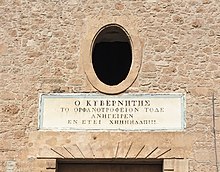
Back Атычная сістэма злічэння Byelorussian Numeració àtica Catalan Griechische Zahlen German Αττικό σύστημα αρίθμησης Greek Numeración ática Spanish Աթենական թվային համակարգ Armenian Angka Attika ID Атички бројки Macedonian Attische cijfers Dutch Numeração ática Portuguese


The Attic numerals are a symbolic number notation used by the ancient Greeks. They were also known as Herodianic numerals because they were first described in a 2nd-century manuscript by Herodian; or as acrophonic numerals (from acrophony) because the basic symbols derive from the first letters of the (ancient) Greek words that the symbols represented.
The Attic numerals were a decimal (base 10) system, like the older Egyptian and the later Etruscan, Roman, and Hindu-Arabic systems. Namely, the number to be represented was broken down into simple multiples (1 to 9) of powers of ten — units, tens, hundred, thousands, etc.. Then these parts were written down in sequence, in order of decreasing value. As in the basic Roman system, each part was written down using a combination of two symbols, representing one and five times that power of ten.
Attic numerals were adopted possibly starting in the 7th century BCE and although presently called Attic, they or variations thereof were universally used by the Greeks. No other numeral system is known to have been used on Attic inscriptions before the Common Era.[1][2] Their replacement by the classic Greek numerals started in other parts of the Greek World around the 3rd century BCE. They are believed to have served as model for the Etruscan number system, although the two were nearly contemporary and the symbols are not obviously related. [citation needed]